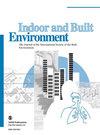Unravelling the microplastic contamination: A comprehensive analysis of microplastics in indoor house dust
IF 2.9
3区 工程技术
Q2 CONSTRUCTION & BUILDING TECHNOLOGY
引用次数: 0
Abstract
Microplastics (MPs), measuring less than 5 mm, have been causing environmental concerns in aquatic ecosystems, and less work has been done in indoor environments, where humans spend most of their lives. This finding revealed a diverse range of MPs within indoor house dust samples. These MPs encompassed fibres, fragments, foams, pellets and films. Due to the ubiquity of textile-based items, fibres are the most common indoor MP. The MPs have different colours like black, red, blue, yellow, white and brown. The study revealed there were substantial differences in MP sizes across different households. The average size range was 178.87–3713.99 µm. One hundred eighteen particles were identified as MPs. The study identified 22 types of MPs, shedding light on these materials’ extensive sources and applications in everyday household items. MPs in indoor environments raise concerns about potential human exposure and underscore the need for further research into their health implications. The MPs found in most indoor house samples were low-density polyethylene, polyethylene, polypropylene, polyamide, polyvinyl chloride, high-density polyethylene and polystyrene. Carbon, nitrogen, fluorine, sodium, sulphur, potassium, calcium, zinc, oxygen and magnesium were the common elements in all indoor house dust samples. Compared with the active sampling, slightly more work has been done on the indoor house dust samples.揭开微塑料污染的神秘面纱:室内灰尘中的微塑料综合分析
尺寸小于 5 毫米的微塑料(MPs)一直是水生生态系统中的环境问题,而在人类生活最长时间的室内环境中,这方面的研究却较少。这一发现揭示了室内灰尘样本中的各种多孔物质。这些多孔材料包括纤维、碎片、泡沫、颗粒和薄膜。由于纺织品无处不在,纤维是最常见的室内 MP。这些 MP 具有不同的颜色,如黑色、红色、蓝色、黄色、白色和棕色。研究显示,不同家庭的 MP 大小差异很大。平均尺寸范围为 178.87-3713.99 微米。有 118 个颗粒被鉴定为 MP。研究确定了 22 种 MP,揭示了这些材料的广泛来源和在日常家居用品中的应用。室内环境中的 MPs 引起了人们对人类可能接触 MPs 的担忧,并强调了进一步研究 MPs 对健康影响的必要性。在大多数室内样本中发现的多孔材料包括低密度聚乙烯、聚乙烯、聚丙烯、聚酰胺、聚氯乙烯、高密度聚乙烯和聚苯乙烯。碳、氮、氟、钠、硫、钾、钙、锌、氧和镁是所有室内尘埃样本中的常见元素。与主动采样相比,对室内灰尘样本所做的工作稍多一些。
本文章由计算机程序翻译,如有差异,请以英文原文为准。
求助全文
约1分钟内获得全文
求助全文
来源期刊

Indoor and Built Environment
环境科学-工程:环境
CiteScore
6.40
自引率
25.00%
发文量
130
审稿时长
2.6 months
期刊介绍:
Indoor and Built Environment publishes reports on any topic pertaining to the quality of the indoor and built environment, and how these might effect the health, performance, efficiency and comfort of persons living or working there. Topics range from urban infrastructure, design of buildings, and materials used to laboratory studies including building airflow simulations and health effects. This journal is a member of the Committee on Publication Ethics (COPE).
 求助内容:
求助内容: 应助结果提醒方式:
应助结果提醒方式:


